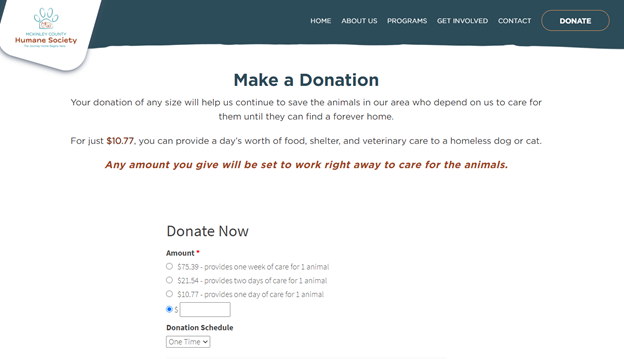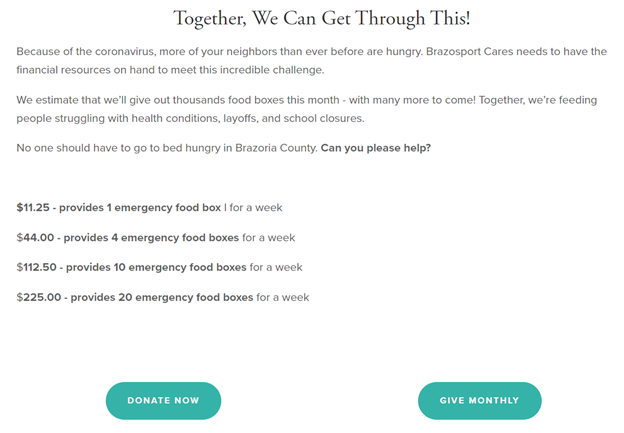
People have a need to do good in the world, but most don’t have the time to do it themselves.
Clicking the “Donate Now” button or writing a check is a simple way for them to fulfil their own personal philanthropic needs to make a difference in the world without actually getting out of their chair.
So, if people WANT to give, why does fundraising seem so hard?
Why does it feel so uncomfortable to ask for money?
The key to raising more money and making fundraising easier is knowing what to say to inspire someone to give.
You must ask for money in a way that people can easily understand, connect with emotionally, and immediately see how their donation will be used.
After helping thousands of small nonprofits over the past decade or so, I’ve seen the successes and failures of folks trying to raise money.
Let me show you something that works every time, even if you aren’t the most articulate person in the world, don’t like fundraising, or are just getting started.
With this strategy, you can take the pressure off of asking for money because the Ask is no longer about you…it’s about those you help.
What is it?
We call it your Core Number.
Find Your Core Number
The days of asking people to give simply because you’re a nonprofit are long gone.
No one wants to give to support your annual fund, help you reach your arbitrary annual goals, or help you fund your budget.
Donors just don’t really care about those things anymore.
But what DO they care about?
They care about the difference your nonprofit is making in the world. And they care about the lives you’re changing (or saving).
 So, ask them to give an amount that means something and relates to the good work you’re doing.
So, ask them to give an amount that means something and relates to the good work you’re doing.
This is where your Core Number comes in.
Your Core Number quickly explains how much it costs you to deliver a unit of service.
When you calculate your Core Number, you’ll have something that meaningfully represents what your nonprofit does.
And, most importantly, it’s a number that donors will respond to.
Ready to crunch some numbers?
Start With Your Unit of Service
Simply put, your Core Number is an expression of what it costs your nonprofit to deliver a unit of service — i.e. the smallest piece of good work your nonprofit does.
For some nonprofits, their unit of service is obvious, like a day’s worth of care for a dog or a cat or one meal at a soup kitchen.
For others, you may have to think about it a little bit to boil everything down to find that smallest common denominator.
If you have several programs that don’t seem to have anything in common, it can be a little tricky. Take a step back and see what your programs have in common – maybe an hour of counseling or an hour of education. It’s really about finding the commonality across programs and then finding the smallest piece of that commonality.
Here are some ideas for units of service for various kinds of nonprofits:
| Food Banks/Pantries | 1 meal for 1 person |
| Animal Shelter | 1 day/night’s care for 1 animal |
| Homeless Shelter | 1 night’s stay for 1 person |
| After School program | 1 hour of tutoring/care for 1 student |
| Arts (Theatre, ballet, etc.) | 1 hour of performance/experience for 1 attendee |
| Health Care/Free Medical Clinic | 1 treatment or visit for 1 person |
| Housing (like Habitat for Humanity) | 1 day of living in their own home for 1 family |
So what’s YOUR nonprofit’s unit of service?
If you aren’t sure, make a list of all your programs and try to determine the unit of service for each one. Once you get a few, you might see what they have in common and be able to work with that.
Depending on your situation, you might need to crunch a Core Number for each program. This is really helpful if you plan to write grants or raise money for individual programs throughout the year.
Once you determine your unit of service, you’re ready to start crunching your Core Number.
Crunch Your Core Number

Your Core Number is a calculation that includes ALL your expenses, both direct and indirect, and the total number of units of service your nonprofit delivers.
The easiest way to figure out your Core Number is to look at your actual numbers from last year (either fiscal year or calendar year — whatever’s easiest for you). If your nonprofit is new and you don’t have data from last year, use estimates for the coming year to crunch your number.
To calculate your Core Number, you need two things:
- Total expenses, and
- Total number of units of service.
Finding total expenses is pretty easy – pull a report from your accounting software of everything you spent during the year.
Don’t try to include just the direct expenses because it doesn’t give a true picture of what it costs you to deliver a unit of service. You need everything it costs to run your nonprofit, so include ALL costs in the calculation to get a more accurate Core Number.
Once you have those and your units of service, it’s time to do some simple math.
Divide the total expenses by the total units of service. The answer is your Core Number. In other words:
Total expenses ÷ Total units of service = Core Number
Got it? Let’s work an example, just to be sure.
Let’s say an animal shelter THINKS its unit of service is taking care of one dog. They rescue a dog, feed it, shelter it, and find it a home. Seems simple enough, right?
Yes…but let’s dig deeper.
If that shelter spent $500,000 last year running their facility (that’s their total cost), and they cared for 3,500 dogs during that year, that means each unit of service (care for 1 dog) cost them $142.86.
$500,000 ÷ 3,500 dogs = $142.86
How do you think that will work if you ask people to give $142.86? Some people might give, but it won’t be an overwhelming response. (And you want a lot of people to respond to raise the kind of money you need!)
So let’s look again and see if there’s a smaller unit of service.
The shelter knows (because they’ve measured it) that the average dog stays 3 weeks (that’s 21 days). Let’s divide that cost to care for a dog by the number of days it will stay in the shelter and see what the cost for 1 day of care is:
$142.86 ÷ 21 days = $6.80 per day

NOW we’re talking! We’ve just found a Core Number!
Now we can ask donors to give $6.80 to provide food, shelter, veterinary care, and love to a homeless dog.
And I promise you, donors WILL respond to something like that.
A Core Number of $20 or less is good. Most people will give that amount. Even better is a Core Number of $10 or less which is a very easy “yes” for most people!
If yours is higher than $20, look and see if there’s a smaller unit of service. Or be ready to explain why it’s higher.
For example, a client of ours did the math and found out their Core Number was $51.23 to provide a day’s care to a rescued dog. As you can imagine, they had some serious heartburn about that and were worried that people wouldn’t give that much. After reviewing everything, we realized that the dogs they take in ALL have serious medical or behavioral issues. Most require many sessions of training and/or extensive medical treatment before they’re adoptable. So, when we explained the higher-than-normal veterinary expenses and the behavioral training, $51.23 didn’t seem so high anymore. We used the number in their next appeal with a quick explanation and people gave.
Once you find your Core Number, you can use multiples to provide other levels for giving:
- $6.80 = 1 day of care
- $47.60 = 1 week of care ($6.80 x 7 days)
- $95.20 = 2 weeks of care ($6.80 x 14 days)
- $142.86 = entire stay ($6.80 x 21 days)
Trust me, people will give when you present it this way.
This is a tangible, meaningful amount that a donor can visualize and they’ll love writing their check or clicking the Donate Now button when they are clear about the impact their donation will have.
A Few More Examples
Here are some examples of gifts I’ve personally made in the last year that are Core Numbers:
- $6.20 to provide a day’s care (shelter, food, veterinary care) for a homeless pet
- $8 to provide heartworm preventative to a homeless dog
- $12 for a day’s care for a draft horse rescued from an auction
- $28.13 to provide food, tuition, books, and clothes to a child in Africa
- $35 to provide food, shelter, and education to an orphan girl in India
By the way, all of these numbers are REAL — they’re not estimated or rounded up or rounded down.
I find it interesting how the human mind works and that for some reason, we like odd numbers better. It’s just more believable. An even number feels like it might have been someone’s guess or just pulled from thin air, and we may feel tricked somehow.
So, don’t round your Core Number. If it comes out to $7.46, use that number. It instantly builds trust because your donor thinks you have a good understanding of your numbers. And we trust people who seem to know what they’re doing.
Here are some more examples of Core Numbers in action.



Now It’s Your Turn…
Now is a great time to find your Core Number just in time to use it for the holidays.
If you’re not a numbers person or just don’t want to do the math, we’ve got you covered. Click here to use our Core Number Calculator once you’ve gathered your total expenses and total number of units of service, and we’ll calculate it for you.
Once you find your Core Number, use it everywhere you tell your story to help people understand what it costs for you to change a life.
You should feel less pressure when you’re asking for money, because you’re asking people to support something in your program. You should see more donations come in when you use your Core Number. And hopefully, you’ll feel more confident with your upcoming fundraising because you have a better idea of how to word your Ask.







WGCA 88.5 fm The Mix’s Core Numbers…
2016 total expenses: $572,864.79
Hours of operation 8760 = $65.40 cost per hour to operate
1/2 hour 17,520 = $32.70 cost per 1/2 hour to operate
We play 12 songs per hour, give or take.
That’s 288 songs per day; 105,120 songs per year
Some Core Numbers…
Each song cost $5.45
One hour of or 12 songs… $65.40
Two hours of or 24 songs… $130.80
Four hours of or 48 songs… $261.60
One day of songs… $1,569.60
Love it Terry! You have some simple numbers to help people understand how they can best help you. I love that $5.45 provides a song which is about 3 minutes of joy for thousands of listeners, right?
Sandy
Any advice for an organization that does several things and serves several different types of clients/audiences? Does it change the equation if people pay for some of our services (dance classes where students pay tuition)? We’re struggling to get to a single core number that would speak to all of our constituents.
Hi Anne, when you have several very different programs, you may need to calculate your core number per program so as you’re talking to people about a specific program, you have a specific number to share. I’d also try to take a step back and see what all your programs have in common and try to calculate a number across the board. Sometimes it can be done and sometimes it can’t. The more curious you are, the more you’ll find. And the more information you have the better you will be at fundraising.
How do you combine core numbers with a list of benefits the donor gets in exchange for making donations of various levels (ex. donation of $1000 = meet and greet with the dancers, etc.)? Having a lot of trouble trying to do that. ChoreoNova’s core numbers:
$8.84 can fund a half hour of dancer and studio hire to rehearse.
$17.68 can fund a full hour of rehearsal.
$141.43 can fund a whole day of rehearsal.
$348.43 can fund one minute of completed dance onstage (rehearsal, costumes, props, and music licensing).
$1200 can fund all rehearsal space hire for “Coupled.”
$2400 can fund the development of an entire (20+ minute) dance piece to go onstage.
Benefit increments usually go $5, $10, $25, $50, $100, $250, $500, $1000, etc. and don’t match the core numbers
Any advice for how to combine using a set of core numbers with various reward levels? Rewards levels usually go $5, $10, $25, $50, $100, $250, $1000, or some such and won’t match odd non-rounded numbers like core numbers. Should the rewards (really thank-you’s) go by core number values instead? I have to say that it looks a bit odd to use core numbers with decimals in them when listing the thank-you’s and I’ve never seen any organization do it that way.
Hi Davida, I’m not sure what you mean by reward levels. I’m guessing that if someone gives you $x, they get a free something. If you’re going to use your core number in your marketing and asks, I would definitely use that number and multiples for reward levels to keep everything tied together. Remember that most people give to help make something good happen through your nonprofit, not to get something in return. If they’re all about the reward, they’re not truly a donor.
This article helped me so much! We teach meditation classes in prison and each two hour class costs about $250 and I wasn’t sure how to get a smaller core number but then you helped me realize that we have 20+people in class so $10 provides a meditation class for an incarcerated person! Thanks
Perfect! $10 for a class that will teach someone how to calm their mind so they can make better choices? That sounds like a bargain!
[…] all students have the wherewithal to create fundraising efforts, which can cause a great deal of […]
[…] Use compelling statistics to create a fact-based story that will drive people to do something. […]
[…] if you should use your Core Number to share what it prices to feed that little one lunch, even […]
I like very much sandy rees
So glad!